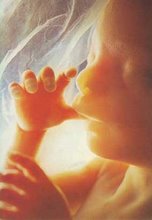Fr. Frank Pavone
National Director, Priests for Life
Like it or not, the Elections of 2008 are closer than we think, and we have less time than we think to choose the next President and Congress of the United States of America. Because so much is at stake, such as the makeup of the Supreme Court (and there has been an undeniable change there), we have to shake ourselves out of all weariness, pessimism, indifference or cynicism, and get to work on informing ourselves about the process and the candidates.
For the first time since 1928, neither an incumbent president nor an incumbent vice president is running for his party's nomination. This election, for both parties, is an open contest. An ABC poll revealed that 65% of Americans said, back in February, that they were already "following closely" the Presidential race.
The large number of states holding early primary elections could compress the nomination campaign season down to just a few weeks long. In the 2000 election cycle, by early February only about 2% of nominating convention delegates had been selected. However 2008 will see over 40% of the delegates chosen by early February. In fact, February 5 is being called "Super Duper" (or "Tsunami") Tuesday. We will very likely know the Presidential nominees by the end of that day.
Between now and then, therefore, how do we figure out what candidate to back in the primary elections?
Obviously, the positions of both the candidate and his or her party have to be examined closely. (See www.votinginfo.org for more information.) Some positions, like support for abortion, contradict the meaning of public service so profoundly that, from a moral dimension, they disqualify a candidate.
Among candidates who have generally acceptable positions, one needs to consider a number of other factors. What is the "electability" of the candidate; that is, how much momentum, money, and manpower does the candidate have to wage his or her campaign? How is the candidate doing in the polls, particularly polls among likely voters, and polls that match the candidate against likely opponents?
Another important question is what kinds of issues, positions, or characteristics of the candidate will be likely to either attract or repel voters who may not be thinking of the same issues that we find important.
In addition, what kind of coalitions can the candidate build? How does the candidate appeal to various segments of the population - such as Hispanics and Blacks, for example? In what states does the candidate have strength? There are certain combinations of key states that are critical to winning a Presidential race, and candidates need to be evaluated on their ability to carry those states.
One of the websites that can help make sense out of the confusing world of politics, and give us insight into some of the questions above, is www.RealClearPolitics.com. My own website on these topics is www.PoliticalResponsibility.org.
All these tools can help us decide what to do in the upcoming election. We have to choose a primary candidate now, and support that candidate strongly.
This column can be found online at www.priestsforlife.org/columns/columns2007/07-11-05elections2008.htm
Fr. Frank's columns can be heard via podcast. See www.priestsforlife.org/podcast for more details.
Were there to be no support in the whole history of ethical and moral thought, were there no acknowledged confirmation from medical science, were the history of legal opinion to the contrary, we would still have to conclude on the basis of God's Holy Word that the unborn child is a person in the sight of God. He is protected by the sanctity of life graciously given to each individual by the Creator, Who alone places His image upon man and grants them any right to life which they have.
Tuesday, November 6, 2007
Elections 2008: Clarity or Confusion?

